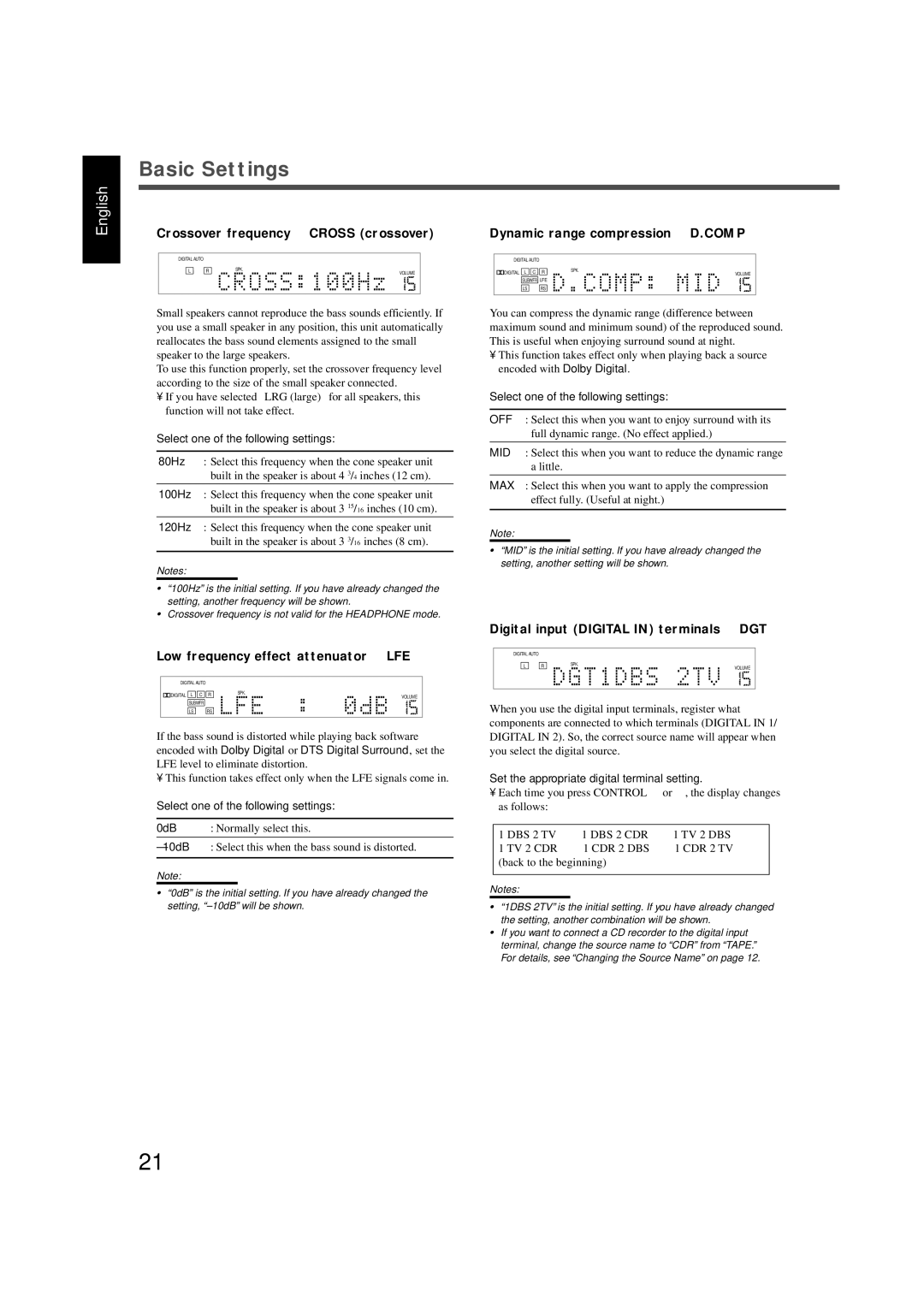
English
Basic Settings
7 Crossover | 7 Dynamic range |
DIGITAL AUTO |
|
| |
L | R | SPK. | |
VOLUME | |||
|
|
Small speakers cannot reproduce the bass sounds efficiently. If you use a small speaker in any position, this unit automatically reallocates the bass sound elements assigned to the small speaker to the large speakers.
To use this function properly, set the crossover frequency level according to the size of the small speaker connected.
•If you have selected “LRG (large)” for all speakers, this function will not take effect.
Select one of the following settings:
80Hz : Select this frequency when the cone speaker unit built in the speaker is about 4 3/4 inches (12 cm).
100Hz : Select this frequency when the cone speaker unit built in the speaker is about 3 15/16 inches (10 cm).
120Hz : Select this frequency when the cone speaker unit built in the speaker is about 3 3/16 inches (8 cm).
Notes:
•“100Hz” is the initial setting. If you have already changed the setting, another frequency will be shown.
•Crossover frequency is not valid for the HEADPHONE mode.
DIGITAL AUTO |
|
|
DIGITAL L C | R | SPK. |
VOLUME | ||
SUBWFR LFE |
| |
LS | RS |
|
|
|
|
You can compress the dynamic range (difference between maximum sound and minimum sound) of the reproduced sound. This is useful when enjoying surround sound at night.
•This function takes effect only when playing back a source encoded with Dolby Digital.
Select one of the following settings:
OFF : Select this when you want to enjoy surround with its full dynamic range. (No effect applied.)
MID : Select this when you want to reduce the dynamic range a little.
MAX : Select this when you want to apply the compression effect fully. (Useful at night.)
Note:
•“MID” is the initial setting. If you have already changed the setting, another setting will be shown.
7Low frequency effect attenuator—“LFE”
DIGITAL AUTO |
|
|
DIGITAL L C | R | SPK. |
VOLUME | ||
SUBWFR |
|
|
LS | RS |
|
|
|
|
If the bass sound is distorted while playing back software encoded with Dolby Digital or DTS Digital Surround, set the LFE level to eliminate distortion.
•This function takes effect only when the LFE signals come in.
Select one of the following settings:
0dB : Normally select this.
Note:
•“0dB” is the initial setting. If you have already changed the setting,
7Digital input (DIGITAL IN) terminals—“DGT”
DIGITAL AUTO |
|
| |
L | R | SPK. | |
VOLUME | |||
|
|
When you use the digital input terminals, register what components are connected to which terminals (DIGITAL IN 1/ DIGITAL IN 2). So, the correct source name will appear when you select the digital source.
Set the appropriate digital terminal setting.
•Each time you press CONTROL 3 or 2, the display changes as follows:
1 DBS 2 TV “ 1 DBS 2 CDR “ 1 TV 2 DBS “ 1 TV 2 CDR “ 1 CDR 2 DBS “ 1 CDR 2 TV “ (back to the beginning)
Notes:
•“1DBS 2TV” is the initial setting. If you have already changed the setting, another combination will be shown.
•If you want to connect a CD recorder to the digital input terminal, change the source name to “CDR” from “TAPE.” For details, see “Changing the Source Name” on page 12.
21
